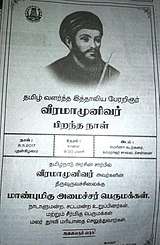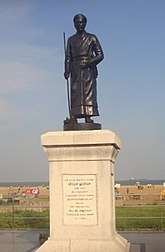Constanzo Beschi
| Constantine Joseph Beschi | |
|---|---|
| Born |
8 November 1680 Castiglione delle Stiviere, Italy |
| Died | 4 February 1747, Kingdom of Cochin, India |
| Resting place | Sampaloor, Kerala |
| Other names | Veeramamunivar |
Constantine Joseph Beschi (8 November 1680 – 4 February 1742), also known under his Tamil name of Vīramāmunivar, was an Italian Jesuit priest, missionary in South India, and Tamil language littérateur.
Early years
Born in Castiglione delle Stiviere,[1] Beschi got his secondary education in the Jesuits' High School at Mantua. After becoming a Jesuit in 1698,[2] he was trained in Ravenna and Bologna from where he requested and obtained, from Superior General Michelangelo Tamburini, permission to be sent to the Jesuit mission at Madurai in South India. Sailing from Lisbon he reached Goa in October 1710, from where he proceeded immediately to South India. He arrived in Madurai in May 1711.
In South India
Inspired by what was done in China, Beschi adopted the native Tamilians' lifestyle in his life and in his missionary work. For example, he adopted the saffron coloured robe generally worn by a sannyasi (Indian ascetic). He visited several important centres such as Tirunelveli, Ramanathapuram, Thanjavur and, of course, Madurai to learn the Tamil language. He met with persecution in 1714–15 and escaped a death sentence. This gave him more time to master the Tamil language in which he soon showed great proficiency.[1]
During the first six years, he worked as a missionary in Elakurichy, a town near Tiruvaiyaru. Then he served as parish priest in Kamanayakkanpatti, one of the oldest mission centres in Tamil Nadu. He worked in the Thanjavur area till 1738 and settled in 1740 on the Coromandel coast where he remained till the end of his life.
He helped build the Poondi Matha Basilica at Poondi near Thanjavur, Vyagula Matha Church at Thanjavur, The Perianayagi Madha Shrine,[3] Konankuppam at Mugasaparur in Konankuppam, and Adaikala Maadha Shrine at Elakurichi.[4] These churches are now Catholic pilgrim centres.
He died at Ambalakaadu in Thrissur, Kingdom of Cochin (now a part of the state of Kerala), and is buried at Sampaloor, where his tomb can be seen.
Contribution to Tamil literature

Constantine compiled the first Tamil lexicon - a Tamil-Latin dictionary. He also compiled the comprehensive Chaturakarati (சதுரகராதி), a quadruple lexicon containing words, synonyms, and categories of words and rhymes.[5]
He translated and explained in Latin the "Thirukkural", an epic poem of Thiruvalluvar. This Latin work was an eye opener for European intellectuals, enabling them to discover truth and beauty in Tamil literature. He also translated into European languages several other important Tamil literary works such as Devaaram (தேவாரம்), Thiruppugazh (திருப்புகழ்), Nannool (நன்னூல்) and Aaththichoodi (ஆத்திசூடி).[4]
Besides composing literary Tamil Grammar work, he also wrote a grammar for the common use of Tamil (Urai nadai illakkiyam - உரை நடை இலக்கியம்), which at times led to him being referred to as the 'Father of Tamil Prose'.[6]
Earlier Tamil scripts were written without the tittle (புள்ளி) for consonants, and the symbol ர was used to indicate long vowels. It was Veeramamunivar who introduced the system of dotting the Tamil consonants (க், ங், ச், ... ) and writing the long vowels as ஆ instead of அர, கா instead of கர, etc.[7][5][8][9][10]
His biggest poetical work is the Thembavani (தேம்பாவணி - The Unfading Garland - an ornament of poems as sweet as honey), 3615 stanzas long on salvation history and the life of Saint Joseph. He also wrote a prabandham (a minor literature) called Kaavalur Kalambagam (காவலூர் கலம்பகம்), a grammatical treatise called Thonnool (தொன்னூல்), a guide book for catechists with the title Vedhiyar Ozukkam (வேதியர் ஒழுக்கம்), and Paramarthaguruvin Kadhai (பரமார்த்த குருவின் கதை - The Adventures of Guru Paramartha), a satirical piece on a naive religious teacher and his equally obtuse disciples. His prose works include polemical writings against the Lutheran missionaries and didactic religious books for the instruction of Catholics.[4]
Recognition

In 1968, the State of Tamil Nadu erected a statue for Beschi on the Marina beach in the city of Madras as a recognition for his contribution to Tamil language and literature.
See also
References
- 1 2 "CATHOLIC ENCYCLOPEDIA: Costanzo Giuseppe Beschi". Newadvent.org. Retrieved 2018-05-28.
- ↑

- ↑ "Archived copy". Archived from the original on 18 January 2010. Retrieved 3 November 2009.
- 1 2 3 "Huge bronze statue to be installed at Veeramamunivar church". The Hindu. Special Correspondent. 2015-02-23. ISSN 0971-751X. Retrieved 2018-05-27.
- 1 2 "வீரமாமுனிவர் பிறந்தநாள் - சிறப்பு பகிர்வு". Vikatan (in Tamil). 2013-11-08. Retrieved 2018-05-27.
- ↑ "வீரமாமுனிவர் - Father Constantine Joseph Beschi". tamilnation.co. Retrieved 2018-05-27.
- ↑ Subramanian, Dr S Ve (May 1978). Thonnool Vilakkam. Chennai: Tamil Pathippagam. pp. 25–26.
- ↑ வீரமாமுனிவர், Veeramamunivar (1838). Thonnool Vilakkam தொன்னூல் விளக்கம். Pondycherry.
- ↑ Srinivasa Ragavacharya, Veeramamunivar,. "ஐந்திலக்கணத் தொன்னூல் விளக்கம்". tamildigitallibrary.in. Retrieved 2018-05-29.
- ↑ "வீரமாமுனிவரின் எழுத்துச் சீர்திருத்தம் | தமிழ் இணையக் கல்விக்கழகம்". www.tamilvu.org. Retrieved 2018-05-29.
- Giachi, G.: L'India divenna la sua terra, Milan. 1981.
- Sorrentino, A:: L'altra perla dell'India, Bologna, 1980.
Further reading
- Besse, L.: Fr.Beschi: his times and his writings, Trichinolopy, 1918.